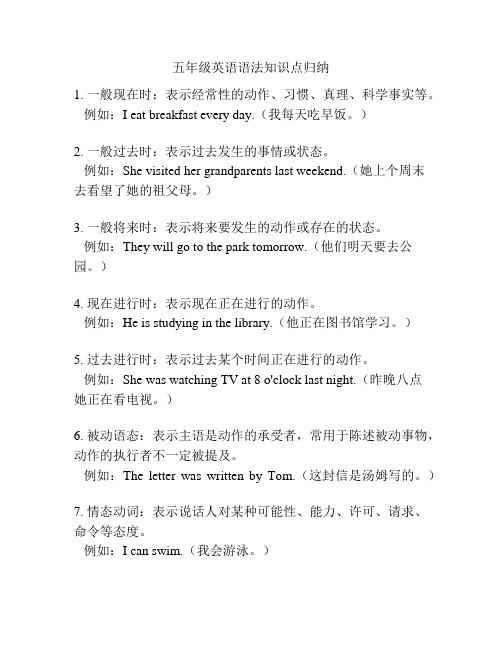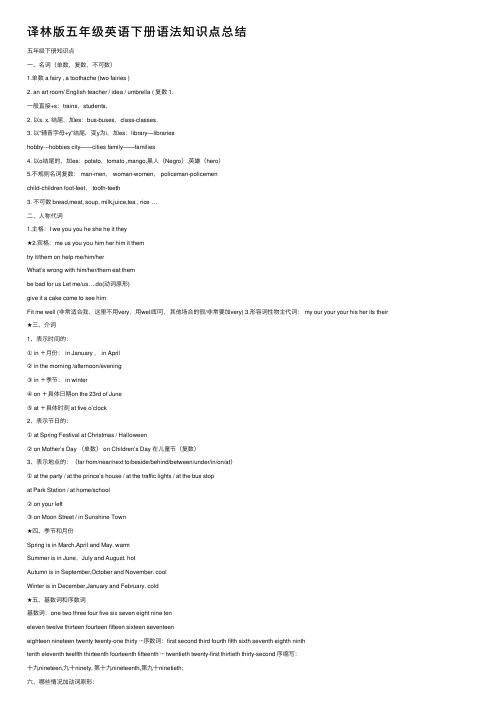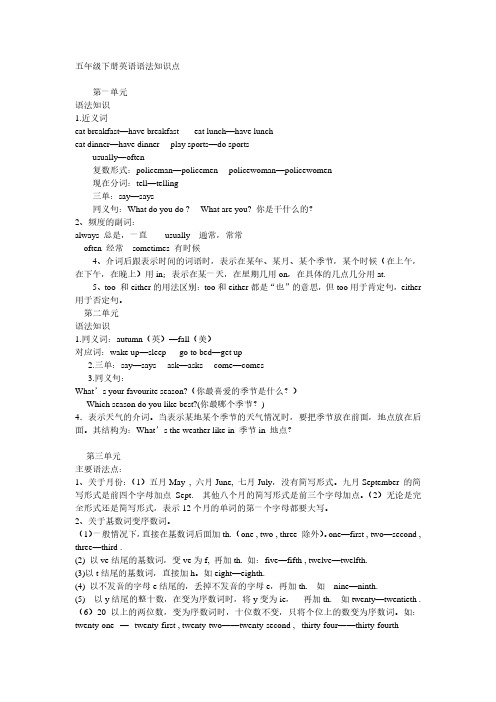五年级下册英语语法知识点
人教版五年级英语下册重点句型及语法

人教版五年级英语下册重点句型及语法第一单元1、其他日常活动:eat breakfast 吃早饭 eat lunch吃午饭 eat dinner 吃晚饭get up起床 go to bed 上床睡觉 wash my clothes 洗我的衣服watch TV看电视 go swimming 去游泳 go running去跑步do homework 做作业 do kungfu练武术 play ping-pong打乒乓球play football踢足球 play basketball打篮球 play the pipa弹琵琶play music 演奏音乐 finish class 结束上课 start class 开始上课in the water/sea 在水里/在海里 is good at 擅长 get off 逃脱 lots of 许多2、频度副词。
always总是,一直(100%)usually通常(80%) often 经常(60%)sometimes(30%)有时3、疑问词。
when什么时候 why 为什么 what 什么重点句型。
1、询问别人什么时候做某事的句型及回答。
句型结构:问:When do you+动词短语原形+其他?(你/你们什么时候做某事?)答:I/we(+频度副词)+动词短语原形+at+具体时间(我/我们通常在几点做某事。
)例:问:When do you go to bed?(你什么时候上床睡觉?)答:I go to bed at 9:00p.m (我晚上9点上床睡觉。
)注意:当主语是第三人称单数(he,she,it,单个人名或单数名词)时,助动词do要变成doe s,句型结构是:when does+主语(第三人称单数)+动词短语原形+其他?2、询问别人周末做什么的句型及回答。
句型结构:问:What do you do on the weekend?(你周末做什么?)答:I(+频度副词)+动词(短语)+其他。
新译林版英语五年级下册语法知识详解

新译林版英语五年级下册语法知识详解本文将详细介绍新译林版英语五年级下册的语法知识,帮助学生更好地理解和掌握课程内容。
1. 一般现在时一般现在时是表达现在情况或经常性行为的时态。
主语与动词保持一致,即第三人称单数主语使用动词的原形加s。
例如:- I like playing soccer.- He eats an apple every day.2. 一般过去时一般过去时是表达过去发生的事情或状态的时态。
常与表示过去的时间状语连用,如yesterday, last week等。
动词的过去式通常为动词原形加-ed,但也有一些不规则动词需要特殊记忆。
例如:- She watched a movie yesterday.- They visited their grandparents last summer.3. 现在进行时现在进行时表示现在正在进行的动作或发生的事情。
由"be"动词加动词-ing形式构成。
例如:- We are studying English now.- He is playing soccer in the park.4. 情态动词情态动词是用来表示能力、请求、建议、许可、可能性等情态的词汇,常与动词原形搭配使用。
例如:- Can you help me with my homework?- You should eat more vegetables.5. 形容词比较级和最高级形容词比较级用于比较两个人或事物的程度,最高级则用于比较三个以上的人或事物的程度。
常通过在形容词后加-er或-est来构成。
例如:- This book is more interesting than that one.- He is the tallest boy in the class.以上是新译林版英语五年级下册的一些语法知识详解。
希望同学们能通过学习掌握这些知识,提高英语水平。
英语五年级下册第二单元语法

英语五年级下册第二单元语法在五年级下册第二单元中,英语语法重点主要是现在进行时(Present Continuous Tense)和现在完成时(Present Perfect Tense)。
现在进行时是一种表示正在进行的动作或存在的状态的时态。
它的构成形式是“be动词(am,is,are)+动词的现在分词(动词+ing)”。
例如,“I am studying”表示“我正在学习”。
这种时态强调的是当前正在发生的事情,而不是已经完成的事情。
现在完成时则是一种表示过去发生的动作对现在造成的结果的时态。
它的构成形式是“have/has+动词的过去分词(动词+ed)”。
例如,“I have finished my homework”表示“我已经完成了我的作业”。
这种时态强调的是过去发生的动作对现在产生的影响或结果。
这两种时态在英语中都是非常重要的,它们在不同的语境中有着不同的用法。
现在进行时通常用于描述正在发生的动作或状态,而现在完成时则用于描述过去发生的动作对现在的影响或结果。
在使用这两种时态时,我们需要根据语境来选择合适的时态。
在这个单元中,学生需要学习如何正确使用这些时态,例如在问句和答句中如何使用,以及在什么情况下使用。
他们也需要理解这两种时态的区别和用法。
此外,这个单元不仅涉及词汇和句型的学习,还强调对位置关系的理解和运用。
通过学习表达位置的词汇,如“in”、“on”、“under”等,学生能够更好地描述物品的位置。
同时,通过掌握表达位置关系的句型,如“Where's the ...? It's in/on/under...”,学生能够在实际场景中运用这些语言知识,提高语言实际运用能力。
在学习过程中,学生需要积极思考、练习和运用这些词汇和句型,加深对位置关系的理解,提高语言技能。
这个单元的目标是帮助学生掌握英语的基础语法和词汇,并能够在实际情境中运用这些知识。
五年级英语语法知识点归纳

五年级英语语法知识点归纳1. 一般现在时:表示经常性的动作、习惯、真理、科学事实等。
例如:I eat breakfast every day.(我每天吃早饭。
)2. 一般过去时:表示过去发生的事情或状态。
例如:She visited her grandparents last weekend.(她上个周末去看望了她的祖父母。
)3. 一般将来时:表示将来要发生的动作或存在的状态。
例如:They will go to the park tomorrow.(他们明天要去公园。
)4. 现在进行时:表示现在正在进行的动作。
例如:He is studying in the library.(他正在图书馆学习。
)5. 过去进行时:表示过去某个时间正在进行的动作。
例如:She was watching TV at 8 o'clock last night.(昨晚八点她正在看电视。
)6. 被动语态:表示主语是动作的承受者,常用于陈述被动事物,动作的执行者不一定被提及。
例如:The letter was written by Tom.(这封信是汤姆写的。
)7. 情态动词:表示说话人对某种可能性、能力、许可、请求、命令等态度。
例如:I can swim.(我会游泳。
)8. 动词的时态变化:根据不同的时态,动词会发生相应的变化。
例如:go(一般现在时)→ goes(第三人称单数一般现在时)→ went(一般过去时)→ gone(过去分词)9. 形容词的比较级和最高级:用于比较两个或更多事物的大小、程度等。
例如:My sister is taller than me.(我姐姐比我高。
)10. 介词:用于表示事物之间的位置、关系等。
例如:The pen is on the table.(笔在桌子上。
)11. 不定代词:表达不确定或泛指的代词。
例如:Somebody called you.(有人给你打电话。
)12. 句子的结构:主语+谓语+宾语,疑问句的谓语和助动词需要进行调换。
译林版五年级英语下册语法知识点总结

译林版五年级英语下册语法知识点总结五年级下册知识点⼀、名词(单数,复数,不可数)1.单数 a fairy , a toothache (two fairies )2. an art room/ English teacher / idea / umbrella ( 复数 1.⼀般直接+s:trains,students,2. 以s. x. 结尾,加es:bus-buses,class-classes,3. 以“辅⾳字母+y”结尾,变y为i,加es:library—librarieshobby---hobbies city——cities family——families4. 以o结尾的,加es:potato,tomato ,mango,⿊⼈(Negro),英雄(hero)5.不规则名词复数: man-men, woman-women, policeman-policemenchild-children foot-feet, tooth-teeth3. 不可数 bread,meat, soup, milk,juice,tea , rice …⼆、⼈称代词1.主格:I we you you he she he it they★2.宾格:me us you you him her him it themtry it/them on help me/him/herWhat’s wrong with him/her/them eat thembe bad for us Let me/us….do(动词原形)give it a cake come to see himFit me well (⾮常适合我,这⾥不⽤very,⽤well即可,其他场合的很/⾮常要加very) 3.形容词性物主代词: my our your your his her its their ★三、介词1、表⽰时间的:① in +⽉份: in January , in April② in the morning /afternoon/evening③ in +季节: in winter④ on +具体⽇期on the 23rd of June⑤ at +具体时刻 at five o’clock2、表⽰节⽇的:① at Spring Festival at Christmas / Halloween② on Mother’s Day (单数) on Children’s Day 在⼉童节(复数)3、表⽰地点的:(far from/near/next to/beside/behind/between/under/in/on/at)① at the party / at the prince’s house / at the traffic lights / at the bus stopat Park Station / at home/school② on your left③ on Moon Street / in Sunshine Town★四、季节和⽉份Spring is in March,April and May. warmSummer is in June,July and August. hotAutumn is in September,October and November. coolWinter is in December,January and February. cold★五、基数词和序数词基数词:one two three four five six seven eight nine teneleven twelve thirteen fourteen fifteen sixteen seventeeneighteen nineteen twenty twenty-one thirty ···序数词:first second third fourth fifth sixth seventh eighth ninthtenth eleventh twelfth thirteenth fourteenth fifteenth ··· twentieth twenty-first thirtieth thirty-second 序缩写:⼗九nineteen,九⼗ninety, 第⼗九nineteenth,第九⼗ninetieth;六、哪些情况加动词原形:/should /would 2. let 3.助动词 do/does练习: Hai should ______(take) some medcine.’s go and ______(have)a party.(do)Nancy ______ (like) _______(dance)has to ______(come) back before 12 o’clock.七、哪些情况加动词ing2. go good at /how about注意:动词ing形式也叫作动词的现在分词(-ing),变化规则:(1)直接加ing:draw——drawing play——playing(2)以不发⾳的e结尾的,去e加ing:dance——dancing skate——skating make——making have——having write——writing live——living come------coming ride -------riding drive------driving(3)以重读闭⾳节结尾,呈现“辅元辅”结构的,双写末字母加ing:swim——swimming run——running chat——chattingsit——sitting put ——putting shop——shoppingget-----getting练习:’s go ________(swim) this afternoon.’re really good at _________(skate).(be) your uncle ______(read) books nowabout ________(watch) a film★⼋、现在进⾏时表⽰:正在进⾏的动作或存在的状态。
人教版新起点五下英语知识点

五年级下册英语语法知识点第一单元语法知识1.近义词eat breakfast—have breakfast eat lunch—have luncheat dinner—have dinner play sports—do sportsusually—often复数形式:policeman—policemen policewoman—policewomen现在分词:tell—telling三单:say—says同义句:What do you do ? ---What are you? 你是干什么的?2、频度的副词:always 总是,一直usually通常,常常often 经常sometimes 有时候4、介词后跟表示时间的词语时,表示在某年、某月、某个季节,某个时候(在上午,在下午,在晚上)用in;表示在某一天,在星期几用on,在具体的几点几分用at.5、too 和either的用法区别:too和either都是“也”的意思,但too用于肯定句,either 用于否定句。
第二单元语法知识1.同义词:autumn(英)—fall(美)对应词:wake up—sleep go to bed—get up2.三单:say—says ask—asks come—comes3.同义句:What’s your favourite season?(你最喜爱的季节是什么?)----Which season do you like best?(你最哪个季节?)4.表示天气的介词。
当表示某地某个季节的天气情况时,要把季节放在前面,地点放在后面。
其结构为:What’s the weather like in 季节in 地点?第三单元主要语法点:1、关于月份:(1)五月May , 六月June, 七月July,没有简写形式。
九月September 的简写形式是前四个字母加点Sept.其他八个月的简写形式是前三个字母加点。
小学五年级下册英语重点语法:一般将来时
◆ 一般疑问句:Be动词 + 主语 + going to+动原+其它?
如:Are they going to have an English test nexபைடு நூலகம் week?
他们下周有英语考试吗?
◆ 特殊疑问句:
特殊疑问词+ be动词 + 主语 +going to+动原+其它?
★一般将来时态的定义:
表示将要发生的动作或存在的状态。
如: I will see a film tomorrow.
我明天将去看一场电影。
He will be 10 years old next year.
明年他就十岁了。
★一般将来时态的标志词:
1、tonight(今晚)
2、soon(不久;很快)
3、tomorrow系列:tomorrow morning/afternoon/evening
the day after tomorrow(后天)
4、next系列:next week/ next year/ next Monday...
5、一段时间+later系列:five years later/ three days later…
6、in + 一段时间系列:in five minutes/in two weeks…
如:They are going to have an English test next week.
他们下周有一场英语考试。
◆ 否定句:主语 + be动词+ not +going to+动原+其它.
如:They aren't going to have an English test next week
五年级的英语语法知识点
五年级的英语语法知识点
五年级的英语语法知识点包括:
1. 时态:现在时、过去时、将来时
2. 人称代词:主格、宾格、物主代词
3. 句子种类:陈述句、疑问句、祈使句、感叹句
4. 比较级和最高级:形容词和副词的比较级和最高级形式
5. 名词的数:单数和复数形式
6. 及物动词和不及物动词:需要宾语和不需要宾语的动词
7. 物主代词:表达所有关系的代词
8. 疑问代词:用来提问的代词,如:what, who, when, where, why, how等
9. 名词性从句:以名词作为句子成分的从句
10. 连词:连接不同句子或词组的词,如:and, but, or, because等
11. 形容词的顺序:多个形容词修饰一个名词时的顺序
12. 句子的结构:主语、谓语、宾语、定语、状语
13. 反义词和近义词的用法
14. 条件句:表示条件的句子结构
15. 数词:表达数量的词,如:one, two, three等
16. 祈使句:表示命令、请求或建议的句子结构。
人教版PEP五年级英语下册各单元语法点
人教版PEP五年级英语下册各单元语法点Unit 1: What Does She Do?- 一般现在时:用于描述日常活动或惯。
主语为第三人称单数时,动词加-s或-es。
- 观察寻找规律:第三人称单数的动词加-s或-es。
- Be动词+动词-ing:用于描述正在进行的动作。
主语为第三人称单数时,be动词用is。
- 一般现在时的否定句:在动词前面加don't/doesn't。
- 一般现在时的疑问句:将do/does置于主语之前。
Unit 2: Can You Run?- Can的用法:用于表示能力和询问对方是否能够做某事。
- Can的否定形式:在can后面加not或缩略形式can't。
- Can的疑问形式:将can置于句首。
Unit 3: What Are They Doing?- 现在进行时:用于描述正在进行的动作。
动词加-ing。
- 现在进行时的否定句:在be动词后面加not。
- 现在进行时的疑问句:将be动词置于句首。
Unit 4: I'm Sitting at the Front.- 介词短语表示地点:用于描述人或物所在的位置。
- 介词on、in、under、behind、in front of、next to等的用法。
Unit 5: What Are You Going to Do?- be going to的用法:表示将来要做的事情。
- be going to的否定形式:在be动词后面加not。
- be going to的疑问形式:将be动词置于句首。
Unit 6: It's Raining!- 祈使句:用于表示请求、命令或建议。
动词原形作谓语。
- 祈使句的否定形式:在动词前面加don't。
- 祈使句的疑问形式:用Do开头。
Unit 7: How Often Do You Exercise?- 表示频率的副词:用于描述动作发生的频率。
- always, usually, often, sometimes, hardly ever, never等的用法。
五年级下册剑桥英语语法
五年级下册剑桥英语语法一般现在时一般现在时:表示经常做的、习惯性做的动作或目前的状况。
1、第三人称单数做主语,动词词尾加“s”动词词尾加“s”规则:1)直接加2)以o、s、x、sh、ch结尾,加es3)“辅音字母+y结尾”,变y为i加es肯定句:Sb(三单)+动词s+其它。
否定句:Sb(三单)+doesn’t+动词原形+其它。
(句中加doesn’t,动词还原,其余不变)一般疑问句:Does+某人+动词原形+其它?(句首加does,动词还原,其余不变)Yes does./ No doesn’t.2、其它人称做主语,动词用原形肯定句:Sb+动词+其它。
否定句:Sb+don’t+动词原形+其它。
(句中加don’t,其余不变)一般疑问句:Do+某人+动词原形+其它?(句首加do,其余不变)Yes,do./ NoModule 3短语:have or breakfast吃......作为早饭have for lunch吃......作为午饭have h for dinner吃......作为晚饭其中,可以为这些食物:bread, meat, hamburger, fish,egg, sausages, sandwich, fish and chips, rice, noodles, cake dumplings等。
4、have got有三单形式为has got5、give = give to 把某物给某人6、buy =buy for 给某人买某物7、like y much非常喜欢某人/某物8、不规则动词过去式:give--gave eat--ate buy--bought have--had write 句子:1、--What did she have for breakfast?她吃什么作为早餐?--She had eggs and sausages.2、--What did you have for dinner?--I had fish and chips.3、 had a sandwich because she doesn’t like hamburgers.(对“because+句子”提问,要用疑问词why)4、He likes hamburgers very much.5、Mum is going to cook Chinese food for us.Sb be(am/is/are)going to do.某人打算做某事。
- 1、下载文档前请自行甄别文档内容的完整性,平台不提供额外的编辑、内容补充、找答案等附加服务。
- 2、"仅部分预览"的文档,不可在线预览部分如存在完整性等问题,可反馈申请退款(可完整预览的文档不适用该条件!)。
- 3、如文档侵犯您的权益,请联系客服反馈,我们会尽快为您处理(人工客服工作时间:9:00-18:30)。
三单:say—says
同义句:What do you do ? ---What are you?您就是干什么的?
2、频度的副词:
always总就是,一直usually通常,常常
often经常sometimes有时候
4、介词后跟表示时间的词语时,表示在某年、某月、某个季节,某个时候(在上午,在下午,在晚上)用in;表示在某一天,在星期几用on,在具体的几点几分用at、
(7)序数词的简写形式为表示该词的阿拉伯数字加上该单词的最后两个字母,最后两个字母要变成上标格式。如:first—1st , second—2nd , third—3rd , fourth—4th、twentieth—20th
3、回答When is your birthday?这个问题,如果只说明生日在几月份,在月份前用in、如My birthday is in July、如果要具体说明生日就是在几月几日,则要把in去掉,直接用is,或者在is后加on。如My birthday is June 9th、或My birthday is on June 9th、
2、在电话中表另一个人接电话时,应该说:“Can I speak to…?”
3、告诉别人接电话时,说:There is a call for you、
4、在接电话时请别人稍候说:Hold on please、或者Please hold on、
5、动词变为现在分词(加ing)的规则:
(1)一般情况下,在动词的后面直接加ing、 如:play—playing
clean—cleaning draw—drawing cook—cooking
(2)以单个不发音的字母e结尾的动词,去掉不发音的字母e,再加ing、
如:write—writing come—coming take—taking make—making leave—leaving have—having
(3)以重读闭音世结尾的动词,如果词尾只有一个辅音字母,则要先双写这个辅音字母,再加ing、 如: run—running swim—swimming put—putting sit—sitting set—setting
五单元
主要知识点:
1、在英语中,当表示妈妈时,无论就是人类妈妈还就是动植物的妈妈,都可以用she、 而表示婴儿时,也都可以用it、
5、too与either的用法区别:too与either都就是“也”的意思,但too用于肯定句,either用于否定句。
第二单元
语法知识
1、同义词:autumn(英)—fall(美)
对应词:wake up—sleep go to bed—get up
2、三单:say—says ask—asks come—comes
五年级下册英语语法知识点第Βιβλιοθήκη 单元语法知识1、近义词
eat breakfast—have breakfast eat lunch—have lunch
eat dinner—have dinner play sports—do sports
usually—often
复数形式:policeman—policemen policewoman—policewomen
(4)以不发音的字母e结尾的,丢掉不发音的字母e,再加th、 如nine—ninth、
(5)以y结尾的整十数,在变为序数词时,将y变为ie,再加th、 如twenty—twentieth、
(6)20以上的两位数,变为序数词时,十位数不变,只将个位上的数变为序数词。如:twenty-one--—--twenty-first , twenty-two——twenty-second , thirty-four——thirty-fourth
4、注意区分两个句子:
What day is it today ?今天星期几?
What’s the date today?今天就是几月几日?
5、根据要求写单词:
make (现在分词)---making、send(现在分词)---sending、
6.句子:
How many birthdays are in October ?有几个人的生日在十月?
(1)一般情况下,直接在基数词后面加th、(one , two , three除外)。one—first , two—second , three—third、
(2)以ve结尾的基数词,变ve为f,再加th、如:five—fifth , twelve—twelfth、
(3)以t结尾的基数词,直接加h。如eight—eighth、
读作October the first、
10、同义句:
Who has a birthday in October?===Whose birthday is in October?
第四单元
知识点:
1、在电话中介绍自己时,可以用“It’s…”或者‘This is…、’。但就是不能用“I am…”或者“My name is…”
第三单元
主要语法点:
1、关于月份:(1)五月May ,六月June,七月July,没有简写形式。九月September的简写形式就是前四个字母加点Sept、 其她八个月的简写形式就是前三个字母加点。(2)无论就是完全形式还就是简写形式,表示12个月的单词的第一个字母都要大写。
2、关于基数词变序数词。
There are 3、
7、My birthday is in February、
(变为一般疑问句)---Is your birthday in February?
8、Does she have a computer?她有计算机不?当第三人称单数与句子中出现了does时,其她动词必须使用原型。
9、读序数词时,前面一定要加the、如October 1st、
3、同义句:
What’s your favourite season?(您最喜爱的季节就是什么?)
----Which season do you like best?(您最哪个季节?)
4.表示天气的介词。当表示某地某个季节的天气情况时,要把季节放在前面,地点放在后面。其结构为:What’s the weather like in季节in地点?
